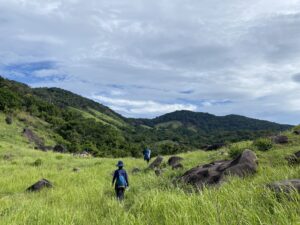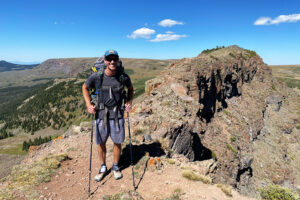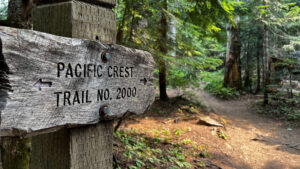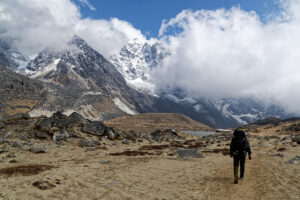Since the pandemic, four long-distance hiking trails have opened around the world. They all differ in distance and difficulty but are ideal for working off your shutdown restlessness.
The Red Sea Mountain Trail: Egypt
The Red Sea Mountain Trail (RSMT) opened in 2019. At 170km, it is mainland Egypt’s first long-distance hiking trail. For the gateway beach resort town of Hurghada, the trail is also a community tourism initiative that aims to preserve the endangered Bedouin culture.
The RSMT is a network of ancient routes that the Bedouin have used for centuries. The Khushmaan clan of the Maaza, Egypt’s largest Bedouin tribe, manages it.
“We want the Red Sea Mountain Trail to diversify Hurghada’s tourism and create a space for slow, immersive travel in which the Bedouin can communicate their rich knowledge of their homeland to outsiders,” Ben Hoffler, one of the founders of the trail, told Afar magazine.

Photo: www.redseamountaintrail.org
Completing the full 170km would take most hikers 10 days. The trail is so new that currently, no hiker has completed the full distance. Though many would see 15-20km a day as a manageable distance, the walk is not easy. There is not a well-trodden path to follow, there is considerable elevation gain, and some sections require exposed scrambling.
Everyone who wishes to tackle the trail must do so with Bedouin guides. For centuries, these nomadic desert tribes have been the only people to walk through these mountains. The guides aim to show visitors the “wisdom and beauty of Bedouin heritage”.

Image: www.redseamountaintrail.org
This month sees the first-ever group trying to complete the full thru-hike. So far people have only completed smaller sections. For those who don’t have 10 days to spare, or who want a less demanding trail, you can choose shorter, flatter guidedcircuits.
The founders of the trail have also created supplementary ‘hiking hubs’. Each hub consists of a web of secondary routes that fork off of the main trail, and centers around a specific mountain massif.
The six hubs can add a further 600km to the journey. The Red Sea Mountain Trail Association is already exploring the idea of expanding the main path into a 1,000km route that follows the Red Sea and provides economic support for other clans and tribes.
The Michinoku Coastal Trail: Japan
In March 2011, a 9.0 magnitude earthquake and tsunami ravaged the northeast coast of Japan. It is the fourth largest earthquake since records began in 1900 and it claimed over 18,000 lives.
In the decade since, Japan has been rebuilding its communities, but one initiative in the Tohoku region has gone relatively unnoticed. Among all the reconstruction, they have also built a new hiking trail.

1,000 km along the coast of Japan. Photo: Walk Japan
The Michinoku Coastal Trail (MCT) stretches for 1,000km along Tohoku’s eastern coastline. Michinoku is the ancient name of the Tohoku area. Officials hope that the trail will increase tourism in the little-known area and help with the region’s long-term recovery.

MCT route map. Photo: Walk Japan
The MCT officially opened in June 2019 but it remains relatively untouched because of COVID travel restrictions. The route connects Hachinohe in Aomori Prefecture with Soma in the Fukushima Prefecture.
This off-the-beaten-track route “follows the Pacific Ocean coast over grassy promenades, through forests, along remote beaches and soaring clifftops and to fishing ports, some tiny with a few one-man boats and others with fleets of ocean-going trawlers,” Paul Christie from Walk Japan told the BBC.

Sanriku Cliffs on the MCT. Photo: Walk Japan
Completing the full trail takes anywhere from 6 to 12 weeks. Those daunted by the prospect of a three-month trek can do smaller sections. The route runs through four prefectures of Japan: Amori, Iwate, Miyagi, and Fukushima.
The Michinoku Coastal Trail website breaks these down even further into 28 smaller hikes. It explains which ones are best for newbies, and which are more challenging.
Grampians Peak Trail: Australia
The Grampians Peak Trail runs 160km through Grampians National Park in Victoria, Australia, from Mount Zero in the north to Dunkfield in the south. The Victoria government bills it as a “challenging” 13-day hike.
The trail traverses several mountains and bypasses waterfalls, sandstone rock formations, grasslands, ravines, and eucalyptus forests. Some of the highlights include the Grand Canyon, the Major Mitchell Plateau, and the summits of Mt. Difficult, Mt. Abrupt, and Mt. Sturgeon.

The Grampians Peak Trail. Photo: www.parks.vic.gov.au
Even though you summit several mountains, the trail was not built as a sporting route or place to see who can complete it the fastest.
Known as Gariwerd to the Djab Wurrung and Jardwadjali, who have lived here for over 22,000 years, the Grampians feature aboriginal rock art, as well as abundant wildlife — 40 different mammals, 28 reptiles, and countless birds. There are also over 1,000 plant species, including 130 types of orchids.

The GPT route. Image: www.parks.vic.gov.au
Navigation is tricky. The route crosses large rocky expanses without a worn trail to show the way, only sporadic yellow markers.
After a decade of work and a cost of $33.2 million, the GPT finally opened in November 2021. Eleven new campsites, deep within the park, offer simple amenities. Water is available either at these campsites or at designated nodes, identified on the trail website.
The Walk of Peace: Slovenia and Italy
The Walk of Peace trail stretches 270km from the Alps to the Adriatic Sea, along the World War I front line between Slovenia and Italy.

An Italian charnel house above the town of Kobarid. Photo: www.culture.si
The Walk of Peace opened in April 2020 and follows the Isonzo Front, which saw 12 battles between Italy and the Austro-Hungarian Empire from 1915 to 1917. Over 350,000 soldiers died here. The trail aims to restore the historical sites in the region.
In part, the trail is a history lesson for active students. Mountains and rivers compete with museums and memorials that give trekkers insight into what the region endured during World War I.

The Walk of Peace. Image: javorca.info
The Walk of Peace begins in Triglav National Park. From here, hikers follow the Soča River through Solvenia’s wine country. Leaving Brda, the trail meanders through the Karst region before descending toward the Adriatic. The endpoint is Trieste, Italy.
The main trail splits into 15 one-day sections and is accessible for hikers of varying abilities. Two further trails and a myriad of smaller paths branch off from the main route. One subtrail leads to Kranjska Gora, a winter sports hotspot. The second ends at the town of Bohinjska Bistrica. Smaller paths loop to historical sites.

The Kolovrat outdoor museum, on the border between Italy and Slovenia. Photo: www.culture.si
Throughout the walk, peace and natural beauty contrast with the setting for wars fomented by kings, politicians, and their generals.
The Island Walk: Canada
Prince Edward Island is Canada’s smallest province, but that doesn’t mean it’s short on attractions. Cradled in the Gulf of St. Lawrence by New Brunswick and Nova Scotia, it’s famous for its red soil, beaches, and seafood.

Prince Edward Island National Park. Photo: Ryan Tir
It’s also the fictional home of Anne of Green Gables and produces outstanding potato crops.
Now, it features the country’s newest hiking trail. The 700km Island Walk spans the picturesque island’s entire perimeter in 32 sections. Hikers can finish it in a month of longish day hikes.

The Island Walk circumnavigates Prince Edward Island.
Along the way, inland and coastal passages reveal beaches, farmland, intermingled hardwood and softwood forests, and cozy towns. The scenic highlights look like they’re ripped right out of a coffee table book.

Teacup Rock, Thunder Cove, Prince Edward Island. Photo: JKRiendeau
Partnering inns and hotels along the way help travelers with various logistics like luggage transfer services and kitchen access.

Knox’s Dam Bed and Breakfast, a cultural heritage site on Prince Edward Island. Photo: Stefan Krasowski
Hiking the trail requires notably minimal equipment — basically, a day pack and a comfortable pair of shoes. Bicycle rental services are also available.
The Island Walk season generally starts in May and ends in October. July and August are heavy tourist months on Prince Edward Island, so note that accommodations might be in peak demand at that time.
The trail officially opened in November 2021. For more information, including FAQs and a section-by-section breakdown, go to theislandwalk.ca.






